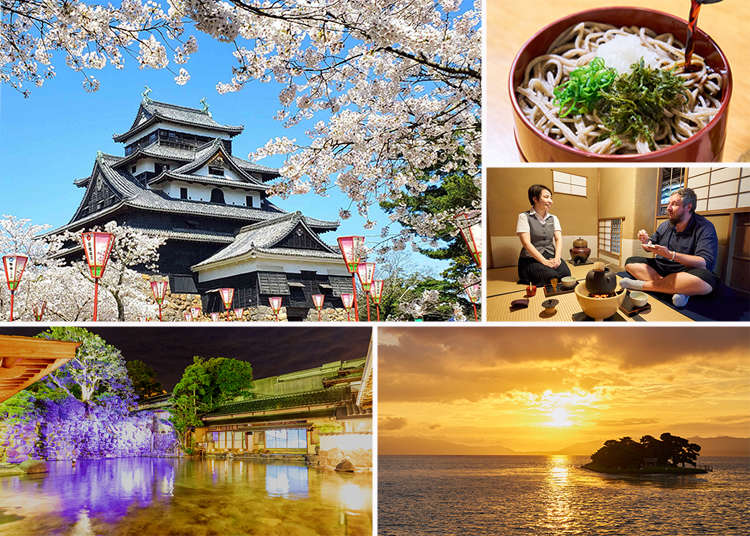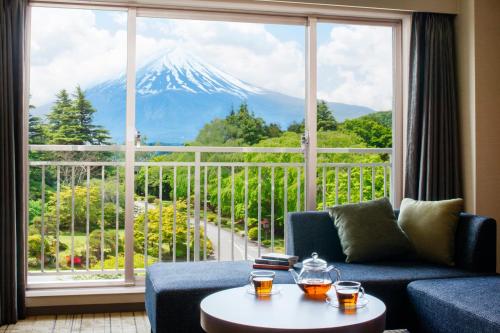
The capital of Shimane Prefecture, in western Japan, is Matsue, which is located between Lake Shinji and Lake Nakaumi with access to the Sea of Japan and the Ohashi River. It is therefore rightly nicknamed the City of Water, yet Matsue’s appeal doesn’t end there. The 400-year-old Matsue Castle overlooks the city, and the Izumo Taisha, a venerable, important Shinto shrine, is readily accessible from there.
It is somewhat off the beaten track, being reachable by air (to Izumo or Yonago Kitaro Airport) or—for the more adventurous—by overnight train from Tokyo (12 hours). However, all the treasures of Matsue, including an encounter with the king of washi paper or the king of flowers, make Shimane’s capital a royal destination that shouldn’t be missed. Here are ten sights and experiences that Matsue has to offer.
*This article includes advertising content.
- Table of Contents
-
- 1.Explore Majestic Matsue Castle
- 2.Experience Matsue’s Culture of Tea
- 3.Relax in Beautifying Hot Springs
- 4.Savor Delicious Soba and Sake
- 5.Take a Trip to Mihonoseki
- 6.Shop with a Scenic View
- 7.Discover Traditional Papermaking
- 8.Visit the Lafcadio Hearn Memorial Museum
- 9.Wander Through the Gardens of Matsue
- 10.Gaze at the Sunset over Lake Shinji
- Matsue Awaits
1.Explore Majestic Matsue Castle

Completed in 1611, Matsue Castle is one of only twelve original Japanese fortifications that have survived centuries of natural disasters. Writer Lafcadio Hearn (1850–1904), who once called Matsue home, wrote about the intimidating, majesty of the castle. With its high walls and spartan interior, Matsue Castle was clearly built for war. Yet there is an undeniable beauty to this designated National Treasure of Japan, like the gentle curves of its roof, which are like the wings of a plover bird—hence its nickname, Plover Castle.

Matsue Castle is also popular for cherry blossom viewing, especially from a sightseeing boat traversing the castle moat with an experienced guide who delights travelers with historical tidbits. English audio recordings about the history of Matsue Castle are also available.

-
Matsue Castle松江城
- Address 1-5 Tonomachi, Matsue, Shimane 690-0887
2.Experience Matsue’s Culture of Tea

The Japanese people of Matsue are some of the biggest consumers of matcha (powdered green tea), which they often enjoy during a tea ceremony. In particular, the Fumai-ryu style developed by the 7th lord of the Matsudaira family, Matsudaira Harusato, is simple and suitable for daily enjoyment as it was created for the samurai class.Visitors can experience it firsthand at Nakamura Chaho, a specialty shop established in 1884, which has its own tearoom for a personal encounter with matcha. Don’t miss a tour of the shop’s aromatic factory (not available on Sundays), where forty electric millstones grind tea leaves to create matcha.


No tea ceremony is complete without traditional Japanese confectionery. For that, we recommend Saiundo, a 150-year-old producer of sweets, like wakakusa (rice cake), which provide a pleasant balance to the natural bitterness of matcha. To round out your tea tour of Matsue, pop into Yakumonuri, a producer of colorful lacquerware that reflects the city’s love of tea-ceremony utensils.

-
Nakamura Chaho中村茶舗
- Address 6-6 Tenjinmachi, Matsue, Shimane 690-0064
-
Saiundo Matsue Main Store彩雲堂 本店
- Address 124 Tenjinmachi, Matsue, Shimane 690-0064
3.Relax in Beautifying Hot Springs

Matsue’s Tamatsukuri Onsen has been known as the “bath of the gods” for over 1,300 years, and traditional inns like the Chorakuen Ryokan, famous for its stunning 33,000-square-meter garden, can be found here. Guests of this popular hot-spring area quickly discover why Shimane is known as the beautiful-skin prefecture. Tamatsukuri waters are widely said to have exceptional moisturizing qualities. The water can be obtained at bottle-filling stations along the Tamayu River, where a free, relaxing foot bath can be enjoyed and picturesque cherry blossoms viewed in the spring.

In addition to the hot springs, visitors can also buy a kanai-ishi (granting stone) at the Tamatsukuriyu Shrine to help make their wishes come true, or pray at the Seigan Temple’s Oshiroi Jizo stone statue, known for helping people achieve beautiful skin!


-
Chorakuen Ryokan & Onsen湯之助の宿 長楽園
- Address 323 Tamayucho Tamatsukuri, Matsue, Shimane 699-0201
4.Savor Delicious Soba and Sake

Izumo is one of the three major varieties of soba (buckwheat noodles) in Japan. Served in a three-tiered bowl and appreciated for its firm texture and earthy flavor, Izumo soba is elevated to new heights at Matsue’s Soba Yuzan. Buckwheat noodles typically make a quick meal, but Yuzan’s soba and sake sommelier assembles a proper feast paired with nihonshu (Japanese sake). Besides noodles, the restaurant serves dried squid pickled in rice malt, sliced soba dumplings, and other foods that work with the sake to enhance the flavor of the handmade noodles.

The restaurant usually recommends a dry, warm sake to go with the soba, preferably one from Shimane, where sake brewing has been documented in myths and the written word for more than a millennium.


-
Soba Yuzanそば遊山
- Address 18 Suetsuguhonmachi, Matsue, Shimane 690-0843, Japan
5.Take a Trip to Mihonoseki

The quiet harbor town of Mihonoseki on the eastern tip of the Shimane Peninsula exudes history and culture, especially at the Miho Shrine. Distinctive for its huge shimenawa (sacred straw rope) strung across the main hall, Miho is Japan’s head shrine dedicated to Ebisu, the jolly god of fishing, prosperity, and music. Just off the approach to the shrine is Aoishidatami-dori, a preserved slice of old Japan with historic inns, an event space, and shops stretching along a retro street paved with stones that acquire a beautiful blue sheen on rainy days.


Cap your trip with a visit to the Mihonoseki Lighthouse on Cape Jizo. Built in 1898, this white candle-like tower with its red-roofed buildings below is surrounded by the verdure of Mihonoseki and overlooks the tranquil blue Sea of Japan—altogether, the scene is a mesmerizing showcase of vivid colors.

-
Mihonoseki Lighthouse美保関灯台
- Address Jizouzaki Mihonoseki, Mihonosekicho, Matsue, Shimane 690-1501
6.Shop with a Scenic View

Established in the Edo period (1603–1868), Ishibashicho was an integral part of Matsue’s castle town, where merchants and artisans gathered. By preserving its historic wooden townhouses and restricting the height of new structures, Ishibashicho today offers visitors a link to the city’s past and a chance to shop within sight of the majestic Matsue Castle. Many of the stores have been here since the 19th century, including Ishikawaya, a fishmonger who also sells kamaboko (fish cakes) and ready-to-eat seafood dishes, all served with a side of old-world allure.

-
Ishikawaya石川屋
- Address 3 Ishibashicho, Matsue, Shimane 690-0881
7.Discover Traditional Papermaking

Developed by craftsman Abe Eishiro (1902–1984), Matsue’s colorful washi (Japanese paper) is collectively known as Izumo Mingeishi, which includes ganpi, called the “king of washi” because of its beautiful hue and durability. You can learn more about this special washi at the Abe Eishiro Memorial Hall—or better yet, make your own washi during a papermaking experience.

Izumo Mingeishi is made from pulped bark, the full processing of which can take up to thirty years. Once the solution is ready, the craftsperson scoops it up using a special wooden frame and then shakes the frame to evenly spread the pulp. The solidified layer is then peeled and dried, creating an artform that has both historical and practical value. In the words of Abe Shinichiro, the grandson of Abe Eishiro, washi reaches completion only when it’s been used. Izumo Mingeishi can be used for ornamental calligraphy, book covers, and even clothing.


-
Abe Eishiro Memorial Hall安部榮四郎記念館
- Address 1754 Yakumocho Higashiiwasaka, Matsue, Shimane 690-2102
8.Visit the Lafcadio Hearn Memorial Museum

Born in Greece, raised in Ireland, and educated in England and France, writer and journalist Patrick Lafcadio Hearn also lived in the United States and Martinique before arriving in Japan in 1890. Having fallen in love with the country, he eventually became a naturalized citizen, taking his wife’s surname, Koizumi. His Japanese first name, Yakumo, is from a traditional poetic allusion to Izumo Province. So even though he had spent only fifteen months in Matsue, Koizumi Yakumo carried a piece of Shimane with him wherever he went.

An author of over thirty books, most about the culture, mythology, and literature of his adopted country, Hearn was once the primary source of information about Japan for people around the world. He has been immortalized in the Lafcadio Hearn Memorial Museum (located next to his former Matsue residence), which houses many of his personal artifacts including his clothing, his beloved Japanese pipes, family photographs, and a displays detailing his international life.

-
Lafcadio Hearn Memorial Museum小泉八雲記念館
- Address 322 Okudanicho, Matsue, Shimane 690-0872
-
Lafcadio Hearn Former Residence国指定史跡 小泉八雲旧居
- Address 315 Kitahoricho, Matsue, Shimane 690-0888
9.Wander Through the Gardens of Matsue

Located on the volcanic Daikon Island in Lake Nakaumi, the Yuushien garden is blessed with over 250 varieties of peonies, known as the “king of flowers,” creating a magnificent kingdom of color. Eschewing the Zen principle of less is more, often reflected in Japanese gardens, Yuushien is bursting with lush trees, colorful flowers, and even a waterfall—yet it never feels like too much. The garden emanates harmony and elegance with a touch of mysticism, especially when the artificially-generated cooling dry mist rolls through during the summer season. The tranquil greenery, with or without the sea of clouds, creates a wonderful background for enjoying a matcha dessert at the garden café.


Also noteworthy is the garden at the Minamikan, an inn established in 1888. Overlooking Lake Shinji, this garden with its 300-year-old pines was voted the fourth best garden in Japan in 2023 by Sukiya Living: The Journal of Japanese Gardening.

-
Yuushien由志園
- Address 1260-2 Yatsukacho Hanyu, Matsue, Shimane 690-1404
-
Minamikan Ryokan皆美館
- Address 14 Suetsuguhonmachi, Matsue, Shimane 690-0843
10.Gaze at the Sunset over Lake Shinji

The seventh largest lake in Japan and the source of the city’s famous shijimi clams, Matsue’s Lake Shinji is also one of Japan’s 100 best spots for viewing a sunset. From Shirakata Park to the Torupa viewing spot, there are several places in the city to enjoy the symphony of amber, red, and yellow colors as the sun sinks into the lake. Be sure to enjoy the sunset against Yomegashima, the sacred and only island in the lake, which you can approach during a Lake Shinji pleasure cruise.
-
Lake Shinji宍道湖
- Address Around Sodechisho,Matsue,, Shimane
Matsue Awaits
Venture beyond the well-trodden path and discover a hidden side of Japan. Castles, gardens, the tea ceremony, hot springs, traditional food including noodle dishes—all the things that we associate with Japan of old are easily found in Matsue, where the unique, local atmosphere is bound to create the memories of a lifetime. We hope to see you there.
- Area
- Category
-
Sponsor Content Japan Travel Encyclopedia
*Prices and options mentioned are subject to change.
*Unless stated otherwise, all prices include tax.
-

Enjoy Fall 2024 with 28 Popular Autumn Tours from Tokyo, Osaka and Kyoto
by: Himanshi Shah
-

Brand New Baths! Top 4 New Bathhouses in and Around Tokyo 2024
by: Cassandra Lord
-

Best Things to Do in Tokyo in November: Fall Colors, Festivals, Events & Illuminations
by: Kaori Kimura
-

Enjoy Japanese Culture When Traveling to Tokyo With These Specially Curated Experiences
by: James Davies
-

From Plant-Based and Gluten-Free to Meat and Cheese, bills Omotesando is The Tokyo Hotspot for ALL Diets
by: Cassandra Lord
-

What’s Tokyo’s Bathhouse Culture Like? Guide Shares Quirky Traditional Edo-Era Sento and Modern Spa Experience
Inspiration for Accommodations
-

Top Ranked Hakone Hotels with Mt. Fuji View: Enjoy Stunning Scenery from Your Private Space
-

Convenient Tokyo Hotels with Airport Shuttle: Ideal for Families and Heavy Luggage
-

Stunning Tokyo Tower View Hotels: Enjoy Spectacular Scenery from Your Private Space
-

Family-Friendly Hotels with Free Shuttle to Disneyland: Convenient Access for a Magical Stay
-

Convenient Asakusa Hotels with Kitchens: Ideal for Extended Family Visits
-

Experience Luxury: Hakone's 10 Best Five-Star Accommodations
-

Enjoy Mt. Fuji Autumn Leaves! Top Hotels Near the Popular Autumn Leaves Corridor
-

Experience Hakone Fall Foliage from Your Room with Stunning Views
-

Enjoy Mt. Fuji from the Comfort of Your Room! Recommended Ryokan with Mt. Fuji View
-

Experience Luxury at Mt. Fuji Resort Hotels! Best Extended Stay Options for Families
-

2022 Marks the 150th Anniversary of Japan’s first railway! “Trains will fly” at the Beyond Station Expo UENO?!
-

What to do if you’re in Tokyo when a disaster strikes? Get familiar with evacuation sites and shelters
by: Miyu Shimada
-

Essential Tokyo: The Complete Guide to Ikebukuro Station
-

Exploring Tokyo: 3 Must-Visit Spots around Tokyo Station
-

6 Surprisingly Cheap Things in Japan
-

Guide to traveling Japan with kids: Advice and tips from a parent in Tokyo!
- #best ramen tokyo
- #what to buy in ameyoko
- #what to bring to japan
- #new years in tokyo
- #best izakaya shinjuku
- #things to do tokyo
- #japanese nail trends
- #what to do in odaiba
- #onsen tattoo friendly tokyo
- #daiso
- #best sushi ginza
- #japanese convenience store snacks
- #best yakiniku shibuya
- #japanese fashion culture
- #best japanese soft drinks














